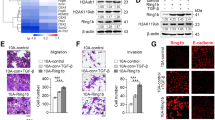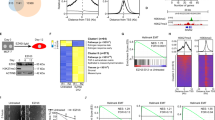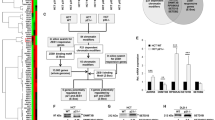Abstract
Loss of E-cadherin is a key initial step in the transdifferentiation of epithelial cells to a mesenchymal phenotype, which occurs when tumor epithelial cells invade into surrounding tissues. Expression of the nuclear factor ZEB1 induces an epithelial-to-mesenchymal transition and confers a metastatic phenotype on carcinomas by repressing the E-cadherin gene at the transcriptional level. In this study, we show that ZEB1 interacts with the SWI/SNF chromatin-remodeling protein BRG1 to regulate E-cadherin independently of CtBP, its traditional co-repressor. Blocking the interaction between ZEB1 and BRG1 induces expression of E-cadherin and downregulation of the mesenchymal marker vimentin. ZEB1 and BRG1 colocalize in E-cadherin-negative cells from cancer lines and in the stroma of normal colon. Colocalization of ZEB1 and BRG1 in epithelial cells is only found in those de-differentiated cells characterized by nuclear β-catenin staining at the invasive edge of the tumor. Our results identify ZEB1/BRG1 as a new transcriptional mechanism regulating E-cadherin expression and epithelial-to-mesenchymal transdifferentiation that may be involved during the initial stages of tumor invasion.
This is a preview of subscription content, access via your institution
Access options
Subscribe to this journal
Receive 50 print issues and online access
$259.00 per year
only $5.18 per issue
Buy this article
- Purchase on SpringerLink
- Instant access to full article PDF
Prices may be subject to local taxes which are calculated during checkout






Similar content being viewed by others
References
Aigner K, Dampier B, Descovich L, Mikula M, Sultan A, Schreiber M et al. (2007). The transcription factor ZEB1 (deltaEF1) promotes tumour cell dedifferentiation by repressing master regulators of epithelial polarity. Oncogene 26: 6979–6988.
Baldus SE, Mönig SP, Huxel S, Landsberg S, Hanisch FG, Engelmann K et al. (2004). MUC1 and nuclear β-catenin are coexpressed at the invasion front of colorectal carcinomas and are both correlated with tumor prognosis. Clin Cancer Res 10: 2790–2796.
Banine F, Bartlett C, Gunawardena R, Muchardt C, Yaniv M, Knudsen ES et al. (2005). SWI/SNF chromatin-remodeling factors induce changes in DNA methylation to promote transcriptional activation. Cancer Res 65: 3542–3547.
Beltran M, Puig I, Peña C, García JM, Alvarez AB, Peña R et al. (2008). A natural antisense transcript regulates Zeb2/Sip1 gene expression during Snail1-induced epithelial-mesenchymal transition. Genes Dev 22: 756–769.
Brabletz T, Jung A, Hermann K, Günther K, Hohenberger W, Kirchner T . (1998). Nuclear overexpression of the oncoprotein beta-catenin in colorectal cancer is localized predominantly at the invasion front. Pathol Res Pract 194: 701–704.
Brabletz T, Jung A, Kirchner T . (2002). Beta-catenin and the morphogenesis of colorectal cancer. Virchows Arch 441: 1–11.
Burkhart BA, Hebbar KB, Trotter KW, Archer TK . (2005). Chromatin-dependent E1A activity modulates NFkB RelA-mediated repression of glucocorticoid receptor-dependent transcription. J Biol Chem 280: 6349–6358.
Bultman SJ, Gebuhr T, Yee D, La Mantia C, Nicholson J, Gilliam A et al. (2000). A Brg1 null mutation in the mouse reveals functional differences among SWI/SNF complexes. Mol Cell 6: 1287–1295.
Burk U, Schubert J, Wellner U, Schmalhofer O, Vincan E, Spaderna S et al. (2008). A reciprocal repression between members of the miR-200 family and ZEB1 promotes EMT and invasion in cancer cells. EMBO Rep 9: 582–589.
Chinnadurai G . (2007). Transcriptional regulation by C-terminal binding proteins. Int J Biochem Cell Biol 39: 1593–1607.
Eger A, Aigner K, Sonderegger S, Dampier B, Oehler S, Schreiber M et al. (2005). δEF1 is a transcriptional repressor of E-cadherin and regulates epithelial plasticity in breast cancer cells. Oncogene 24: 2375–2385.
Fryer CJ, Archer TK . (1998). Chromatin remodelling by the glucocorticoid receptor requires the BRG1 complex. Nature 393: 88–91.
Furusawa T, Moribe H, Kondoh H, Higashi Y . (1999). Identification of CtBP1 and CtBP2 as corepressors of zinc finger-homeodomain factor deltaEF1. Mol Cell Biol 19: 8581–8590.
Glaros S, Cirrincione GM, Palanca A, Metzger D, Reisman D . (2008). Targeted knockout of BRG1 potentiates lung cancer development. Cancer Res 68: 3689–3696.
Gregory PA, Bert AG, Paterson EL, Barry SC, Tsykin A, Farshid G et al. (2008). The miR-200 family and miR-205 regulate epithelial to mesenchymal transition by targeting ZEB1 and SIP1. Nat Cell Biol 10: 593–601.
Grooteclaes ML, Frisch SM . (2000). Evidence for a function of CtBP in epithelial gene regulation and anoikis. Oncogene 19: 3823–3828.
Guaita S, Puig I, Franci C, Garrido M, Dominguez D, Batlle E et al. (2002). Snail induction of epithelial to mesenchymal transition in tumor cells is accompanied by MUC1 repression and ZEB1 expression. J Biol Chem 277: 39209–39216.
Harikrishnan KN, Chow MZ, Baker EK, Pal S, Bassal S, Brasacchio D et al. (2005). Brahma links the SWI/SNF chromatin-remodeling complex with MeCP2-dependent transcriptional silencing. Nat Genet 37: 254–264.
Herranz N, Pasini D, Díaz VM, Francí C, Gutierrez A, Dave N et al. (2008). Polycomb complex 2 is required for E-cadherin repression by the SNAI11 transcription factor. Mol Cell Biol 28: 4772–4781.
Hotz B, Arndt M, Dullat S, Bhargava S, Buhr HJ, Hotz HG . (2007). Epithelial to mesenchymal transition: expression of the regulators snail, slug, and twist in pancreatic cancer. Clin Cancer Res 13: 4769–4776.
Kadam S, Emerson BM . (2003). Transcriptional specificity of human SWI/SNF BRG1 and BRM chromatin remodeling complexes. Mol Cell 11: 377–389.
Liu Y, El-Naggar S, Darling DS, Higashi Y, Dean DC . (2008). Zeb1 links epithelial-mesenchymal transition and cellular senescence. Development 135: 579–588.
Mani SA, Guo W, Liao MJ, Eaton EN, Ayyanan A, Zhou AY et al. (2008). The epithelial-mesenchymal transition generates cells with properties of stem cells. Cell 133: 704–715.
Medina PP, Sanchez-Cespedes M . (2008). Involvement of the chromatin-remodeling factor BRG1/SMARCA4 in human cancer. Epigenetics 3: 64–68.
Moreno-Bueno G, Portillo F, Cano A . (2008). Transcriptional regulation of cell polarity in EMT and cancer. Oncogene 27: 6958–6969.
Onder TT, Gupta PB, Mani SA, Yang J, Lander ES, Weinberg RA . (2008). Loss of E-cadherin promotes metastasis via multiple downstream transcriptional pathways. Cancer Res 68: 3645–3654.
Park SM, Gaur AB, Lengyel E, Peter ME . (2008). The miR-200 family determines the epithelial phenotype of cancer cells by targeting the E-cadherin repressors ZEB1 and ZEB2. Genes Dev 22: 894–907.
Peinado H, Ballestar E, Esteller M, Cano A . (2004). SNAI1 mediates E-cadherin repression by the recruitment of the Sin3A/histone deacetylase 1 (HDAC1)/HDAC2 complex. Mol Cell Biol 24: 306–319.
Peinado H, Olmeda D, Cano A . (2007). SNAI1, Zeb and bHLH factors in tumour progression: an alliance against the epithelial phenotype? Nat Rev Cancer 7: 415–428.
Peter ME . (2010). Regulating cancer stem cells the miR way. Cell Stem Cell 6: 4–6.
Polyak K, Weinberg R . (2009). Transitions between epithelial and mesenchymal states: acquisition of malignant and stem cell traits. Nature Rev Cancer 9: 265–273.
Postigo AA . (2003). Opposing functions of ZEB proteins in the regulation of the TGFb/BMP signaling pathway. EMBO J 22: 2443–2452.
Postigo AA, Dean DC . (1997). ZEB, a vertebrate homolog of Drosophila Zfh-1, is a negative regulator of muscle differentiation. EMBO J 16: 3935–3943.
Postigo AA, Dean DC . (1999a). ZEB represses transcription through interaction with the corepressor CtBP. Proc Natl Acad Sci USA 96: 6683–6688.
Postigo AA, Dean DC . (1999b). Independent repressor domains in ZEB regulate muscle and T-cell differentiation. Mol Cell Biol 19: 7961–7971.
Postigo AA, Dean DC . (2000). Differential expression and function of the zfh-1 family of zinc finger/homeodomain repressors. Proc Natl Acad Sci USA 97: 6391–6397.
Postigo AA, Depp JL, Taylor JJ, Kroll KL . (2003). Regulation of Smad signaling through a differential recruitment of coactivators and corepressors by ZEB proteins. EMBO J 22: 2453–2462.
Postigo AA, Sheppard AM, Mucenski L, Dean DC . (1997). c-Myb and Ets proteins synergize to overcome transcriptional repression by ZEB. EMBO J 13: 3924–3934.
Postigo AA, Ward E, Skeath JB, Dean DC . (1999c). Zfh-1, the Drosophila homologue of ZEB, is a transcriptional repressor that regulates somatic myogenesis. Mol Cell Biol 19: 7255–7263.
Rasband WS . (1997–2004). ImageJ. National Institutes of Health: Bethesda, MD, USA, http://rsb.info.nih.gov/ij/.
Reisman D, Glaros S, Thompson EA . (2009). The SWI/SNF complex and cancer. Oncogene 28: 1653–1668.
Rosen JM, Jordan CT . (2009). The increasing complexity of the cancer stem cell paradigm. Science 324: 1670–1673.
Sentani K, Oue N, Kondo H, Kuraoka K, Motoshita J, Ito R et al. (2001). Increased expression but not genetic alteration of BRG1, a component of the SWI/SNF complex is associated with the advanced stage of human gastric carcinomas. Pathobiology 69: 315–320.
Seo S, Herr A, Lim JW, Richardson GA, Richardson H, Kroll KL . (2005). Geminin regulates neuronal differentiation by antagonizing BRG1 activity. Genes Dev 19: 1723–1734.
Shi Y, Sawada JI, Sui G, Affar EB, Whetsline JR, Lan F et al. (2003). Coordinated histone modifications mediated by a CtBP co-repressor complex. Nature 422: 735–738.
Shirakihara T, Saitoh M, Miyazono K . (2007). Differential regulation of epithelial and mesenchymal markers by deltaEF1 proteins in epithelial mesenchymal transition induced by TGF-beta. Mol Biol Cell 18: 3533–3544.
Singh A, Greninger P, Rhodes D, Koopman L, Violette S, Bardeesy S et al. (2009). A Gene expression signature associated with ‘K-Ras addiction’ reveals regulators of EMT and tumor cell survival. Cancer Cell 15: 489–500.
Spaderna S, Schmalhofer O, Wahlbuhl M, Dimmler A, Bauer K, Sultan A et al. (2008). The transcriptional repressor ZEB1 promotes metastasis and loss of cell polarity in cancer. Cancer Res 68: 537–554.
Sun A, Tawfik O, Gayed B, Thrasher JB, Hoestje S, Li C et al. (2007). Aberrant expression of SWI/SNF catalytic subunits. BRG1/BRM Is associated with tumor development and increased invasiveness in prostate cancers. Prostate 67: 203–213.
Trotter KW, Archer TK . (2008). The BRG1 transcriptional coregulator. Nuc Rec Sign 6: e004.
van Grunsven LA, Michiels C, Van de Putte T, Nelles L, Wuytens G, Verschueren K et al. (2003). Interaction between Smad-interacting protein-1 and the corepressor C-terminal binding protein is dispensable for transcriptional repression of E-cadherin. J Biol Chem 278: 26135–26145.
Vandewalle C, Comijn J, De Craene B, Vermassen P, Bruyneel E, Andersen H et al. (2005). SIP1/ZEB2 induces EMT by repressing genes of different epithelial cell-cell junctions. Nucleic Acids Res 33: 6566–6578.
Vandewalle C, Van Roy F, Berx G . (2009). The role of the ZEB family of transcription factors in development and disease. Cell Mol Life Sci 66: 773–787.
Verstappen G, van Grunsven LA, Michiels C, Van de Putte T, Souopgui J, Van Damme J et al. (2008). Atypical Mowat-Wilson patient confirms the importance of the novel association between ZFHX1B/SIP1 and NuRD corepressor complex. Hum Mol Genet 17: 1175–1183.
Waldmann J, Slater EP, Langer P, Buchholz M, Ramaswamy A, Walz MK et al. (2009). Expression of the transcription factor snail and its target gene twist are associated with malignancy in pheochromocytomas. Ann Surg Oncol 16: 1997–2005.
Wang X, Sansam CG, Thom CS, Metzger D, Evans JA, Nguyen PT et al. (2009). Oncogenesis caused by loss of the SNF5 tumor suppressor is dependent on the activity of BRG1, the ATPase of the SWI/SNF chromatin remodeling complex. Cancer Res 69: 8094–8101.
Wellner U, Schubert J, Burk UC, Schmalhofer O, Zhu F, Sonntag A et al. (2009). The EMT-activator ZEB1 promotes tumorigenicity by repressing stemness-inhibiting microRNAs. Nat Cell Biol 11: 1487–1495.
Yamamichi N, Inada K, Ichinose M, Yamamichi-Nishina M, Mizutani T, Watanabe H et al. (2007). Frequent loss of Brm expression in gastric cancer correlates with histological features and differentiation state. Cancer Res 67: 10727–10735.
Zhang HS, Gavin M, Dahiya A, Postigo A, Ma D, Luo R et al. (2000). Exit from G1 and S phase of the cell cycle is regulated by repressor complexes containing HDAC-Rb-hSWI/SNF and Rb-hSWI/SNF. Cell 101: 79–89.
Acknowledgements
We are indebted to all of the researchers who kindly provided us with cell lines and plasmids (see Supplementary Information). We also thank M Morales (Department Physiological Sciences) and staff from the Technical Science Services at the University of Barcelona for their help in confocal analysis, M Rickman (IDIBAPS) and the Pathology Department at the Hospital Clinic of Barcelona for technical advice and M Parrizas (IDIBAPS) for helpful recommendations on ChIP assays. We are also grateful to R Gasa (IDIBAPS) for critical reading of the paper and J Moore for help with English editing. We apologize to those researchers whose work was cited indirectly through reviews because of space limitations. Initial work in this study was supported by a grant from La Caixa Foundation (BM-06570) to AP. At later stages, this project was funded by the Spanish Ministry of Science and Innovation (MICINN) (BFU2007-60302) and Olga Torres Foundation (FOT-0902) to AP. EST's salary was partly funded by Grant BM-06570.
Author information
Authors and Affiliations
Corresponding author
Ethics declarations
Competing interests
The authors declare no conflict of interest.
Additional information
Supplementary Information accompanies the paper on the Oncogene website
Supplementary information
Rights and permissions
About this article
Cite this article
Sánchez-Tilló, E., Lázaro, A., Torrent, R. et al. ZEB1 represses E-cadherin and induces an EMT by recruiting the SWI/SNF chromatin-remodeling protein BRG1. Oncogene 29, 3490–3500 (2010). https://doi.org/10.1038/onc.2010.102
Received:
Revised:
Accepted:
Published:
Issue Date:
DOI: https://doi.org/10.1038/onc.2010.102



